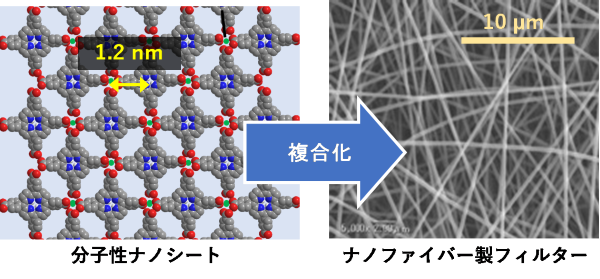2025-05-20 東京大学

図1:ポルフィリンを用いた分子性ナノシートとナノファイバー製フィルターの複合化
<関連情報>
- https://www.iis.u-tokyo.ac.jp/ja/news/4777/
- https://pubs.rsc.org/en/content/articlelanding/2025/ma/d5ma00058k
ナノ粒子捕獲のためのナノファイバー改質布とポルフィリン系ナノシートのハイブリダイゼーション Hybridization of nanofiber-modified fabrics with porphyrin-based nanosheets for nanoparticle capture
Yusuke Kuramochi,Yuna Aoki,Kyoko Enomoto,Seiji Nakamura,Hideyuki Tanaka,Keiichiro Ozawa,Miki Hasegawa,Osamu Ohsawa,Kei Watanabe and Kazuyuki Ishii
Materials Advances Published:20 May 2025
DOI:https://doi.org/10.1039/D5MA00058K
Abstract
Nanoporous filters covering large areas and exhibiting high strength are crucial for capturing small particles, such as viruses. However, the direct capture of nanoparticles requires the layering of numerous fibers, which significantly obstructs air flow. In this study, nanofiber-modified non-woven fabrics are hybridized with two-dimensional porphyrin-based nanosheets. Obtained through the interfacial reaction of a toluene/n-hexanol solution of 5,10,15,20-tetrakis(4-carboxyphenyl)porphyrin with a CuCl2 aqueous solution, the nanosheets feature regular nanopores of a few nanometres. Hybridization is achieved by stamping nanofiber-modified non-woven fabrics onto large-area porphyrin-based nanosheets, covering the mesoporous meshes of the nanofibers with nanopores. Moreover, this coverage is optimized by using nanosheets compressed to different degrees. These hybridized filters capture particles of several tens of nanometres, which are smaller than viruses in size, with a minimal drop in the differential pressure. This study demonstrates not only the utility of molecular nanosheets but also a new approach for hybridizing nanofiber-modified non-woven fabrics.



